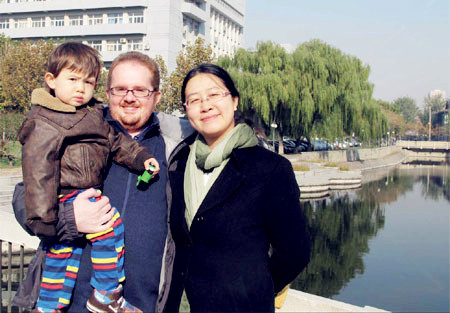Daily life
Good life scientist
By Yang Yang (China Daily)
Updated: 2012-12-10
 |
| Mark Bartlam with his family at Nankai University. Yang Yang / China Daily |
UK biophysicist says Chinese research in war against disease Looks good under the microscope
In his 13 years in China, British biophysicist Mark Bartlam has played a significant part in the robust development of the country's life sciences.
His contribution was recognized last year with a Friendship Award of China from the government.
The Friendship Award is given by the Chinese government as the highest honor to foreign experts for their contribution to China's social and economic development.
Bartlam, professor of structural biology at Nankai University in Tianjin, says research in life sciences is well funded because the government is determined to develop the biotechnology and pharmaceutical industry.
The progress being made and support given is attracting more overseas researchers, particularly returned Chinese researchers.
"It will help improve the research level. It also means that students can have better teachers," says Bartlam at his office in the university's New Life Sciences Building in downtown Tianjian.
Bartlam, 38, is currently teaching a course on virus and tumor-related protein function and structure, and is also leading research into proteins that can be used to develop drugs to fight diseases, including SARS, cancer and influenza, at the State Key Laboratory of Medicinal Chemical Biology.
Research papers have become a vitally important measure for how universities and research institutes in China evaluate the work of academic staff and students.
China is now second to the US in the number of published research papers on life sciences, but the quality of Chinese research has always been subject to criticism.
"The quality is improving and in a few years it will reach the level of the US," Bartlam says.
"The government is very keen to promote biotechnology and the pharmaceutical industry. They want to have a high level of research talent, so they invest a lot in grants, and building high-standard research labs, which are equivalent to or even better than the labs in UK or the US.
"Because of the changes and development of life sciences in the past several years, more research people have come back to China, and the number of labs has increased. These people can bring in more research money, and by forming research teams, we can get more funding together to improve research levels."
Bartlam grew up in a village near Birmingham and developed a talent for science and mathematics. When he was 11, his headmaster asked him to do an IQ test. With a rating of 150, it was suggested he become a nuclear physicist.
And so it was, when he was 18, he chose physics as his major when he went to Imperial College London, later taking a special interest in biophysics."When I studied biophysics, I found I could apply what I learned in physics to problems in biology, particularly problems with human health," he says. "You can develop a lot of tools and techniques to really improve human health. That was very interesting for me. So I chose to continue working on it."
After graduating from Imperial College London, he went to Oxford University to do a PhD on proteins.
Bartlam then applied to undertake post-doctorate research at Cambridge University but was unsuccessful due to funding problems.
A Chinese colleague at Oxford had returned to Beijing and set up a laboratory at Tsinghua University and was looking for researchers. He invited Bartlam to join them for a few months. He stayed for two years and became an associate professor.
After another six years at Tsinghua, Bartlam got a professorship at Nankai University and moved to Tianjin, about 110 kilometers away, where he built his own lab.
Since moving to Tianjin in 2007, work and life has undergone major changes.
The research team he led made significant progress in identifying proteins in flu viruses that can help in the development of new drugs to replace those that have become less effective in combating drug-resistant viruses, such as H5N1 avian flu and H1N1 swine flu, and other strains that are continually changing and evolving.
Based on their findings, they published two papers in Nature in 2008 and 2009.
In 2010, together with Tsinghua University and the Chinese Academy of Sciences, Nankai set up a laboratory in the Binhai New Area of Tianjin, with involvement from local hospitals.
Bartlam's research at Nankai focuses on identifying the proteins in cancer to help develop new drugs. At a certain stage, the projects are moved to a bigger lab in Binhai, where there are facilities for designing and testing potential drug treatments.
Bartlam's connections in the UK also helped him to improve communication and cooperation between scientists in China and Europe.
At Nankai University, he is setting up collaborations with leading UK institutions, including the University of Liverpool and the University of Glasgow, with student exchanges as part of the program.
There has also been an increase in conferences on life sciences.
Bartlam's personal UK-China connections have been especially strengthened. At his birthday party in 2002 at Tsinghua University, he met environmental student Wang Yingying, who was on a visit from Tianjin for two weeks.
Five years later, when Bartlam arrived at Nankai, they were re-introduced to each other and the friendship developed. They were married in September 2009, and their son Mathew was born in November the following year.
Within the next few months, Bartlam and his wife will co-publish a research paper on bacteria that feed on oil, as a possible aid to cleaning up oil pollution.
Zhang Yu contributed to this story.
yangyangs@chinadaily.com.cn
(China Daily 12/07/2012 page18)
